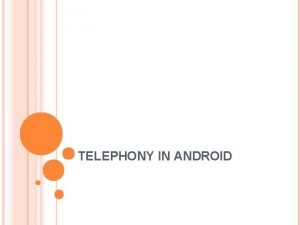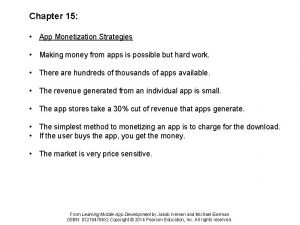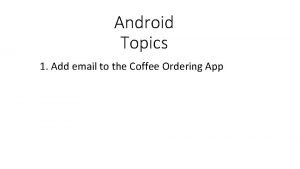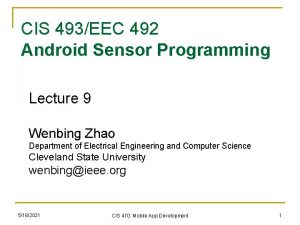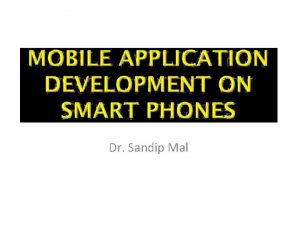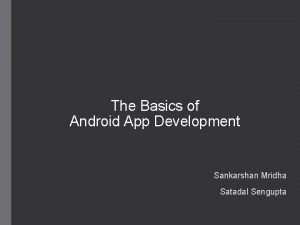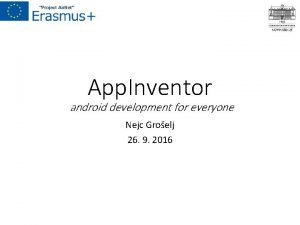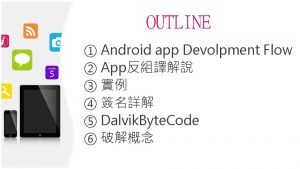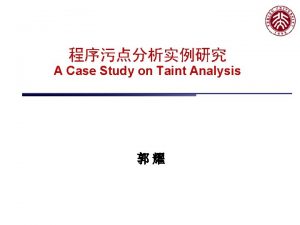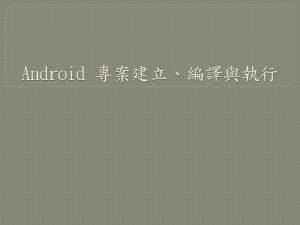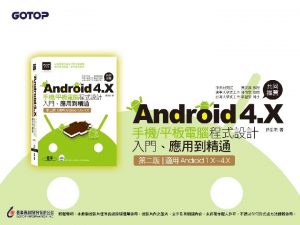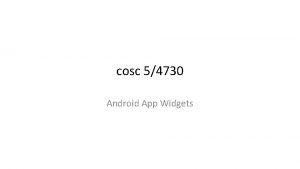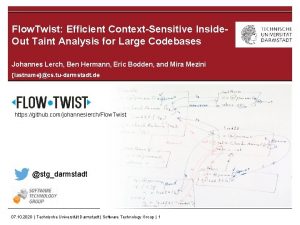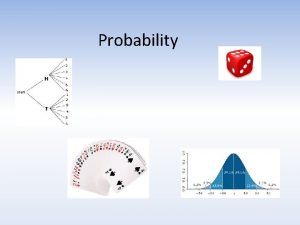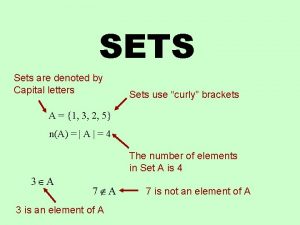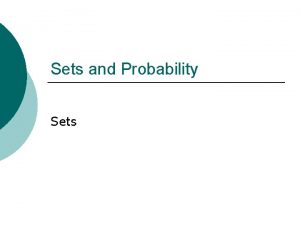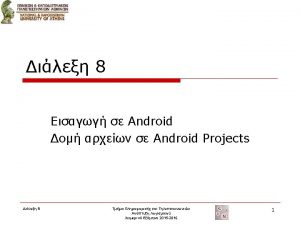Android Taint Flow Analysis for App Sets Will


























- Slides: 26

Android Taint Flow Analysis for App Sets Will Klieber*, Lori Flynn, Amar Bhosale , Limin Jia, and Lujo Bauer Carnegie Mellon University *presenting

Motivation § Detect malicious apps that leak sensitive data. § E. g. , leak contacts list to marketing company. § “All or nothing” permission model. § Apps can collude to leak data. § Evades precise detection if only analyzed individually. § We build upon Flow. Droid. § Flow. Droid alone handles only intra-component flows. § We extend it to handle inter-app flows. 2

Introduction: Android § Android apps have four types of components: § § Activities (our focus) Services Content providers Broadcast receivers § Intentsare messages to components. § Explicit or implicit designation of recipient § Components declare intent filtersto receive implicit intents. § Matched based on properties of intents, e. g. : § Action string (e. g. , “android. intent. action. VIEW ”) § Data MIME type (e. g. , “ image/png”) 3

Introduction § Taint Analysis tracks the flow of sensitive data. § Can be static analysis or dynamic analysis. § Our analysis is static. § We build upon existing Android static analyses: § Flow. Droid [1]: finds intra-component information flow § Epicc [2]: identifies intent specifications [1] S. Arzt et al. , “Flow. Droid: Precise Context, Flow, Field, Object-sensitive and Lifecycle-aware Taint Analysis for Android Apps”. PLDI, 2014. [2] D. Octeau et al. , “Effective inter-component communication mapping in Android with Epicc: An essential step towards holistic security analysis”. USENIX Security, 2013. 4

Our Contribution § We developed a static analyzer called “Did. Fail” (“Droid Intent Data Flow Analysis for Information Leakage”). § Finds flows of sensitive data across app boundaries. § Source code and binaries available at: (or google “Did. Fail SOAP”) http: //www. cert. org/secure-coding/tools/didfail. cfm § Two-phase analysis: 1. Analyze each app in isolation. 2. Use the result of Phase-1 analysis to determine inter-app flows. § We tested our analyzer on two sets of apps. 5

Terminology Definition. A source is an external resource (external to the app, not necessarily external to the phone) from which data is read. Definition. A sink is an external resource to which data is written. For example, § Sources: Device ID, contacts, photos, current location, etc. § Sinks: Internet, outbound text messages, file system, etc. 6

Motivating Example § App Send. SMS. apk sends an intent (a message) to Echoer. apk, which sends a result back. Device ID (Source) Send. SMS. apk start. Activity. For. Result() on. Activity. Result() Echoer. apk intent result get. Intent() set. Result() Text Message (Sink) § Send. SMS. apk tries to launder the taint through Echoer. apk. § Existing static analysis tools cannot precisely detect such inter-app data flows. 7

Analysis Design § Phase 1: Each app analyzed once, in isolation. § Flow. Droid: Finds tainted dataflow from sources to sinks. § Received intents are considered sources. § Sent intent are considered sinks. § Epicc: Determines properties of intents. § Each intent-sending call site is labelled with a unique intent ID. § Phase 2: Analyze a set of apps: § For each intent sent by a component, determine which components can receive the intent. § Generate & solve taint flow equations. 8

Running Example src 1 sink 1 C 1 I 3 src 3 sink 3 I 1 C 2 Three components: C 1, C 2, C 3. C 1 = Send. SMS C 2 = Echoer C 3 is similar to C 1 C 3 • sink 1 is tainted with only src 1. • sink 3 is tainted with only src 3. 9

Running Example src 1 sink 1 C 1 I 3 src 3 sink 3 I 1 C 2 C 3 Notation: 10

Running Example src 1 sink 1 C 1 I 3 src 3 sink 3 I 1 C 2 C 3 Notation: 11

Running Example src 1 sink 1 C 1 I 3 src 3 sink 3 Notation: I 1 C 2 C 3 Final Sink Taints: • T(sink 1) = {src 1} • T(sink 3) = {src 3} 12

Phase-1 Flow Equations Analyze each component separately. Phase 1 Flow Equations: src 1 sink 1 C 2 src 3 sink 3 C 3 Notation • An asterisk (“*”) indicates an unknown component. 13

src 1 Phase-2 Flow Equations Instantiate Phase-1 equations for all possible sender/receiver pairs. Phase 1 Flow Equations: sink 1 I 3 src 3 sink 3 I 1 C 2 C 3 Phase 2 Flow Equations: Notation 14

src 1 Phase-2 Taint Equations sink 1 For each flow equation “src → sink”, generate taint equation “T(src) ⊆ T(sink)”. Phase 2 Flow Equations: Notation I 3 src 3 sink 3 I 1 C 2 C 3 Phase 2 Taint Equations: If s is a non-intent source, then T(s) = {s}. 15

Phase 1 Original APK Epicc Transform. APK Flow. Droid (modified) Extract manifest 16

Implementation: Phase 1 § APK Transformer § Assigns unique Intent ID to each call site of intent-sending methods. § Enables matching intents from the output of Flow. Droid and Epicc § Uses Soot to read APK, modify code (in Jimple), and write new APK. § Problem: Epicc is closed-source. How to make it emit Intent IDs? § Solution (hack): Add put. Extra call with Intent ID. Phase 1 Original APK Epicc Transform. APK Flow. Droid (modified) Extract manifest 17

Implementation: Phase 1 § Flow. Droid Modifications: § Extract intent IDs inserted by APK Transformer, and include in output. § When sink is an intent, identify the sending component. § In base. start. Activity, assume base is the sending component. (Soundness? ) § For deterministic output: Sort the final list of flows. Phase 1 Original APK Epicc Transform. APK Flow. Droid (modified) Extract manifest 18

Implementation: Phase 2 § Take the Phase 1 output. § Generate and solve the data-flow equations. § Output: 1. Directed graph indicating information flow between sources, intent results, and sinks. 2. Taintedness of each sink. 19

Testing Did. Fail analyzer: App Set 1 § Send. SMS. apk § Reads device ID, passes through Echoer, and leaks it via SMS § Echoer. apk § Echoes the data received via an intent § Write. File. apk § Reads physical location (from GPS), passes through Echoer, and writes it to a file 20

Testing Did. Fail analyzer: App Set 2 (Droid. Bench) Int 3 = I(Intent. Sink 2. apk, Intent. Source 1. apk, id 3) Int 4 = I(Intent. Source 1. apk, Intent. Sink 1. apk, id 4) Res 8 = R(Int 4) Graph generated using Graph. Viz. Src 15 = get. Device. Id Snk 13 = Log. i Some taint flows: 21

Limitations § Unsoundness § Inherited from Flow. Droid/Epicc § Native code, reflection, etc. § Shared static fields § Implicit flows § Currently, only activity intents § Bugs § Imprecision § Inherited from Flow. Droid/Epicc § Did. Fail doesn’t consider permissions when matching intents § All intents received by a component are conflated togetheras a single source 22

Use of Two-Phase Approach in App Stores § We envision that the two-phase analysis can be used as follows: § An app store runs the phase-1 analysis for each app it has. § When the user wants to download a new app, the store runs the phase-2 analysis and indicates new flows. § Fast response to user. 23

Did. Fail vs Icc. TA § Icc. TA was developed (at roughly the same time as Did. Fail) by: § Li Li, Alexandre Bartel, Jacques Klein, Yves Le Traon (Luxembourg); § Steven Arzt, Siegfried Rasthofer, Eric Bodden (EC SPRIDE); § Damien Octeau, Patrick Mc. Daniel (Penn State). § Icc. TA uses a one-phase analysis § Icc. TA is more precise than Did. Fail’s two-phase analysis. § Two-phase Did. Fail analysis allows fast 2 nd-phase computation. § Future collaboration between Icc. TA and Did. Fail teams? 24

Conclusion § We introduced a new analysis that integrates and enhances existing Android app static analyses. § Demonstrated feasibility by implementing a prototype and testing it. § Two-phase analysis can be used by app store to provide fast response. § Future work: § § § Implicit flows Static fields Distinguish different received intents Other data channels (file system, non-activity intents) Etc. 25

Thank You
 When the by-products of human actions taint the environment
When the by-products of human actions taint the environment Android telephony architecture
Android telephony architecture App monetization challenges
App monetization challenges Coffee ordering app in android studio
Coffee ordering app in android studio App inventor vs android studio
App inventor vs android studio Web viewer app inventor 2
Web viewer app inventor 2 Lifecycle services android
Lifecycle services android Android application components
Android application components Inventor
Inventor Pedometer accelerometer algorithm android app
Pedometer accelerometer algorithm android app App inventor 2 emulator
App inventor 2 emulator Mal app android
Mal app android Cell broadcast receiver android
Cell broadcast receiver android Android app
Android app App inventor vs android studio
App inventor vs android studio Jive phone system
Jive phone system Gradle task 'wrapper' not found in project
Gradle task 'wrapper' not found in project Bart app
Bart app App ca1 chromeriver com app ca1 chromeriver com
App ca1 chromeriver com app ca1 chromeriver com App on apple app store user
App on apple app store user Apktool 使用
Apktool 使用 Kontinuitetshantering i praktiken
Kontinuitetshantering i praktiken Novell typiska drag
Novell typiska drag Nationell inriktning för artificiell intelligens
Nationell inriktning för artificiell intelligens Ekologiskt fotavtryck
Ekologiskt fotavtryck Shingelfrisyren
Shingelfrisyren En lathund för arbete med kontinuitetshantering
En lathund för arbete med kontinuitetshantering

